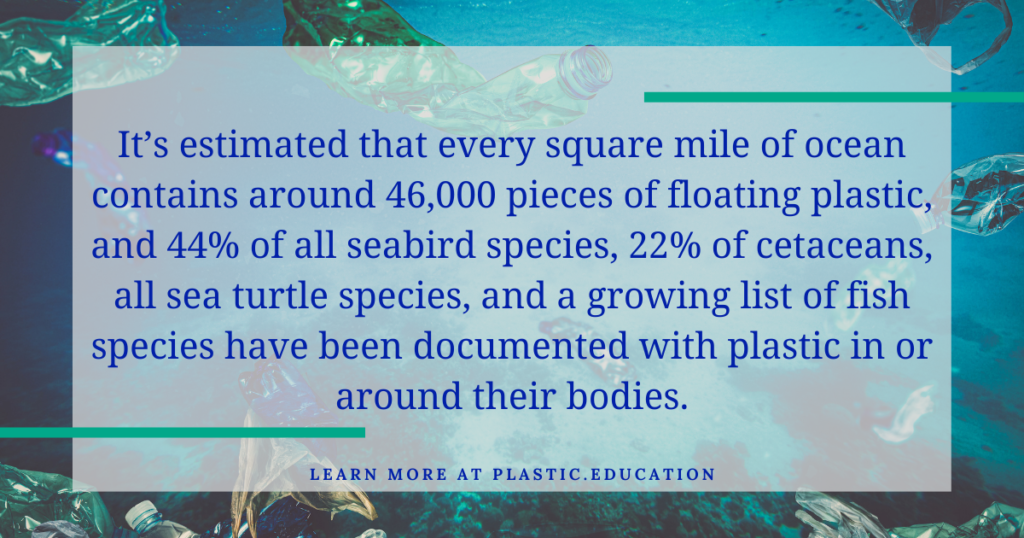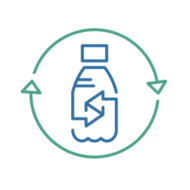HOW DO PLASTICS IMPACT WILDLIFE?
Many creatures mistake plastic for food, which can be deadly when they attempt to eat it. In total, it is estimated that ingestion of plastic kills 1 million marine birds and 100,000 marine animals each year[i].
Birds and animals can die from internal injuries caused by swallowing plastic fragments. Many die from starvation; with stomachs full of indigestible plastic, they feel full and stop eating before slowly succumbing to malnutrition. Turtles often suffocate when attempting to eat floating plastic bags, which to them look just like their favorite food – jellyfish.
Even the tiny plastic beads that enter an animal’s digestive system can affect its health due to the presence of endocrine disruptors. Chemicals such as Bisphenol A (BPA) are used in the production of polycarbonate plastics and epoxy resins, to make water bottles, CDs, food packaging and the lining of food cans.
When BPA leaches out of the plastics, it can affect the endocrine system, which can damage the immune system, reproductive system, neurological responses and affect overall growth. Some fish have also been observed to become feminized or intersex due to their exposure to BPA pollution.
Entanglement in discarded plastic is also a huge danger for wildlife. One report found that roughly 200 different marine species worldwide have been identified suffering entanglements[ii], with plastic ropes, fishing nets, and even soda can holders to blame.
Wildlife suffers on land as well as at sea
This problem is not limited to the oceans; land-based creatures – both wild and domesticated – also suffer injury and death caused by plastic waste.
Animals such as dogs, raccoons and bears looking for food can get their heads stuck in plastic containers, leading to suffocation, dehydration, starvation, and eventual death.
Creatures of all types and sizes also ingest plastic fragments or larger items of packaging by mistake when eating discarded leftover food, which can lead to intestinal blockage and subsequent starvation.
Animals and birds can become tangled in plastic soda can holders, twine or other thin plastic materials, preventing them from walking, hopping or flying, and leaving them vulnerable to predators as well as unable to hunt for food or take shelter.
What types of plastics are the biggest problem?
As far as wildlife is concerned, all plastic pollution is bad. Tiny plastic microbeads enter the food chain via the smallest sea creatures, which are then eaten by predators and end up in the digestive systems of larger fish.
Seabirds eat plastic that is about the same size and shape as the fish that normally forms their diet; anything from plastic cigarette lighters and toothbrushes to cotton buds and small toys. Species such as the albatross, which normally feed on shrimp, pick through the plastic selecting the pink, brown and red pieces mistaking them for their favorite food.
Even very large plastic waste is a problem. Floating debris such as buoys, abandoned boats and parts of docks or pontoons can carry numerous kinds of marine life with them, transferring invasive species or diseases to new areas where they can disrupt the local ecosystem.
How bad is the problem today?
Researchers in Lake Erie found an average of 8 pieces of plastic in small-sized fish, 20 pieces in medium-sized fish and 44 pieces in cormorants, large sea birds that eat these fish[iii].

It’s estimated that every square mile of ocean contains around 46,000 pieces of floating plastic, and 44 percent of all seabird species, 22 percent of cetaceans, all sea turtle species and a growing list of fish species have been documented with plastic in or around their bodies[iv].
Should we be concerned for the future?
The floating mass of plastic known as The Great Pacific Garbage Patch, located off the coast of California, is already twice the size of Texas. With global plastics production expected to increase to 1,124 million tonnes a year by 2050[v], the amount of plastic pollution is set to grow still further.
By polluting habitats with vast accumulations of plastic waste, we have already caused dire and often fatal consequences for wildlife and for entire environmental ecosystems. Isn’t it time we found a way to protect all of the planet’s inhabitants from plastic pollution?

We love your content. Regards from Pissouri Bay Divers from Cyprus.